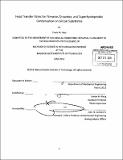Heat transfer rates for filmwise, dropwise, and superhydrophobic condensation on silicon substrates
Author(s)
Hery, Travis M
DownloadFull printable version (2.908Mb)
Other Contributors
Massachusetts Institute of Technology. Dept. of Mechanical Engineering.
Advisor
Evelyn N. Wang.
Terms of use
Metadata
Show full item recordAbstract
Condensation, a two-phase heat transfer processes, is commonly utilized in industrial systems. Condensation heat transfer can be optimized by using surfaces in which dropwise condensation (DWC) occurs, and even further optimized using superhydrophobic surfaces. For superhydrophobic condensation, a structured silicon surface with pillars 2.1 p.m tall, 200 nm in diameter, and a 400 nm pitch was tested. By removing noncondensable gases (NCG) from the system by means of a steam trap, the heat transfer rates of DWC and SHC were found to be greater than that of filmwise condensation (FWC) by a factor of 2, but indistinguishable from each other. The effect of NCG leads to a 5x reduction in heat transfer rates for both DWC and SHC. DWC heat transfer rates are as much as 50 kW/m 2 less than FWC at the same temperature difference, representing a 25% reduction. However, the SHC heat transfer rates remain above those of FWC by as much as 50 kW/m² at the same temperature difference, representing a 20% improvement. These studies suggest that SHC may be a useful passive method to improve condensation heat transfer rates in the presence of NCG. However, it remains to be seen if SHC can provide better heat transfer rates than DWC under saturated steam conditions.
Description
Thesis (S.B.)--Massachusetts Institute of Technology, Dept. of Mechanical Engineering, 2011. Cataloged from PDF version of thesis. Includes bibliographical references (p. 24).
Date issued
2011Department
Massachusetts Institute of Technology. Department of Mechanical EngineeringPublisher
Massachusetts Institute of Technology
Keywords
Mechanical Engineering.